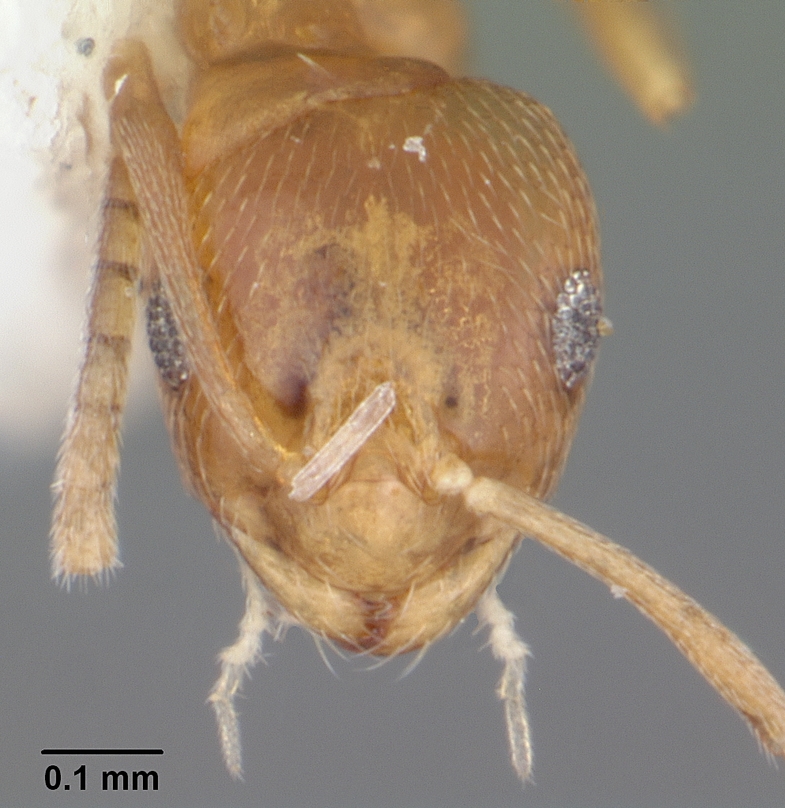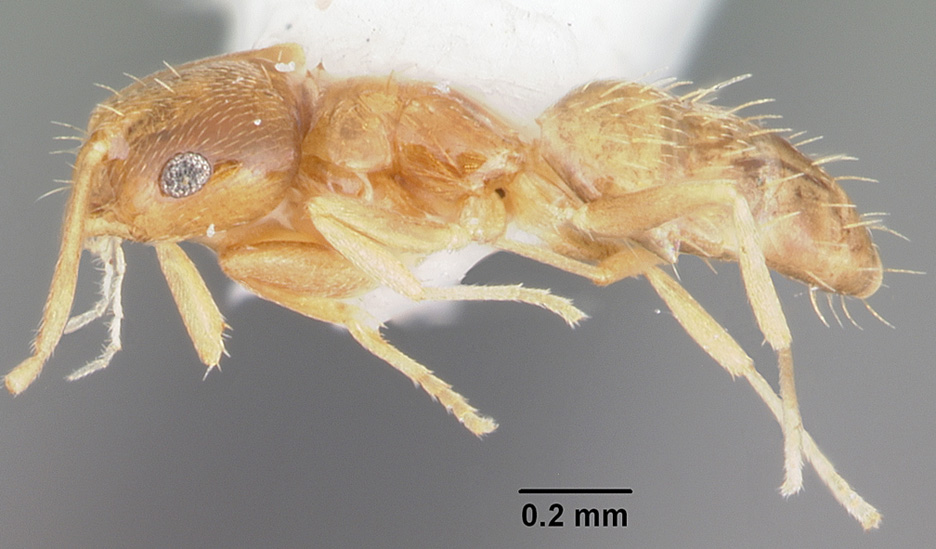Introduction
Brachymyrmex minutus Forel (Formicinae), the minute rover ant, is a minute yellowish brown species native to the Neotropics (Ortiz-Sepulveda 2019). In the US, it is considered to be an introduced species previously only reported from southern Florida, where it is uncommon (Deyrup 2017).
Diagnosis
In the Southeast, the tiny size (TL ≈ 1.3–1.50 mm), yellow coloration, 4–6 stiff erect setae on promesonotal dorsum, absence of ocelli, and nine-segmented antenna will separate workers of B. minutus from other species in the region. Other described yellow species of Brachymyrmex reported from the US lack the stiff, standing setae on the promesonotal dorsum. The exotic B. obscurior and B. patagonicus, also found in the region are brown in color.
Descriptions
Worker (Figure 12): Minute (HL 0.42–0.50 mm, HW 0.41–0.46 mm, EL 0.13–0.14 mm, SL 0.44–0.48 mm, MeSL 0.40–0.46 mm) (n=4, MEM specimens). Yellowish to yellowish brown. Head about as long as wide, with abundant, fine pubescence; eye length about 1/4 of the head length; ocelli absent; antennae nine-segmented, lacking a club; mandibles with five teeth. Mesosoma compact, lacking obvious sculpture, sides of mesosoma shiny, mostly lacking pubescence, dorsum of promesonotum and propodeum with scattered pubescence, dorsum of promesonotum with four or more stiff, semi-erect setae; promesonotum fused and raised; metanotal suture weakly impressed; propodeum broadly sloped, lacking spines. Waist with a single petiolar node, node somewhat flattened and often hidden by gaster from above. Gaster with somewhat sparse appressed pubescence and scattered semi-erect setae; acidopore present.
Queen (Figure 13): (Description based on Antweb photos). Approximately three times longer than worker (TL≈ 3.5 mm). Concolorous yellowish brown. Head about as wide as long, with dense pubescence; eyes large, length more than 1/4 head length; three obvious ocelli present; antenna nine-segmented, lacking club. Mesosoma enlarged, elongated, roundly flattened dorsally; mesosoma with dense, fine pubescence, with scattered, longer, erect setae dorsally; propodeum lacking adornment. Waist with a single petiolar node, often hidden by gaster from above. Gaster enlarged, with fine, dense pubescence and longer stiff erect setae present, especially along tergite margins; acidopore present.
Biology
Little is known about the biology of this species. Deyrup (2017) states that this species was only rarely collected in leaf ltter in Florida. Forel (1893) found subterranean colonies at roots of sod mixed with rock in forests and/or streams. Ortiz-Sepulveda et al. (2019) stated that colonies contain about 50 to 100 workers and have a single queen.
Pest Status
According to Deyrup (2017) this species has only been collected in the southern tip of the state. This tiny species does not possess a sting and is not considered a pest.
Distribution
Brachymyrmex minutus is reported to be a native of the Neotropics, but is also known from the Caribbean region (Antweb 2019); Ortiz-Sepulveda et al. (2019) report this species as occurring in Bolivia, Brazil, Colombia, Costa Rica, Cuba, the Dominican Republic, Ecuador, French Guinana, Guatemala, Mexico, Panama, Paraguay, Peru, Suriname, and Venezula. In the US, confirmed records of this species are known from the southern tip of Florida (Deyrup 2017).
Literature Cited
Deyrup M (2017) Ants of Florida: Identification and Natural History. CRC Press, Boca Raton, FL. 423 pp.
Ortiz-Sepulveda CM, Bocxlaer BV, Meneses AD, Fernández F (2019) Molecular morphological recognition of species boundaries in the neglected ant genus Brachymyrmex (Hymenoptera: Formicidae): toward a taxonomic revision.
Links
Antweb
Antcat
Antwiki
|




